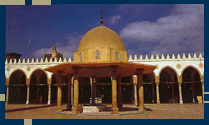Cairo:
History
Fustat
The
Arab armies invaded Egypt in 640 AD and Babylon fell in April
641, after a siege of some seven months. Alexandria was taken
in September 641, and all Egypt was surrendered by the Byzantines
in November of that year. The Arab commander, Amr ibn al-As,
wanted to establish his capital city in Alexandria, but permission
to do so was refused by the Caliph, Umar.
The
reason quoted for his refusal is that he did not want a body
of water to separate the capital from Arabia, so it had to
be built on the east bank of the Nile; however, an attempt
to keep control of the Egyptian forces and their leader may
have been his real motive. The new capital city (called Fustat,
possibly from the Arabic for tent, or camp) was thus established
just to the north of Babylon.
The
new town was laid out as a series of tribal areas, or khittas,
around a central area with the communal mosque, administrative
buildings and residences for the highest status tribal groups.
The majority of tribes who settled here were of Yemeni origin,
with the remainder of the Arabs from the western Arabian peninsula;
a few Jews and some Roman mercenaries were also present.
At
this stage the population must have consisted almost entirely
of soldiers and their households, and Fustat exhibited the
typical plan of a garrison town. Originally founded in 642
AD, the Mosque of Amr still stands but has been continually
rebuilt: nothing remains of the earliest structure. Large
piles of stone- and woodwork have been dumped across the ruins
of the town and these almost certainly came from older versions
of the Mosque and include many reused Roman column capitals.
The
town grew rapidly in size, expanding out into the desert and
up onto higher ground. It became an important commercial center,
and excavations on the site have found artifacts from places
as far apart as China, India, Vietnam, Iraq, Italy and Spain.
|

|
The
Museum of Islamic Art contains many objects from Fustat.
The
city did not retain its status as capital of Egypt; other
administrative districts were planned and built to the north
of Fustat: the Abbasid al-Askar, Tulunid al-Qata'i
and the great Fatimid town al-Qahira, which gives modern
Cairo its name. However, Fustat remained an important trading
post for the eastern Mediterranean world. In 1168 the town
was completely burned to prevent its use by Crusaders, but
it recovered its prosperity and population fairlyquickly.
Fustat eventually declined in importance as trade-routes between
the Far East and Europe shifted northwards, depriving the
town of much of its income. It is unlikely, though, that it
was ever completely abandoned, and until recently a potters'
quarter existed upon the site.
 |
Today,
little remains of the rich city that once flourished on the
site. The area behind the Mosque of Amr has become a convenient
place for Cairo citizens to dump their rubbish and is a desolate
and unhygienic place. Further east, around the ticket office,
house walls still stand and streets can be traced.
A
couple of buildings have been reconstructed to waist height,
and early quarries and the Ayyubid city wall (around the eastern
edge of the site), as well as drainage channels and cisterns,
are still visible. Fustat suffers badly from Cairo's wastewater
problem: stands of reeds, which shelter many bird species,
grow in polluted ponds. Although absolutely fascinating, this
site is really only for those with a reasonable interest in
archaeology or a strong imagination; others will be put off
by the mobs of difficult children often encountered in the
slums around the site. (Alison
Gascoigne)
|
|